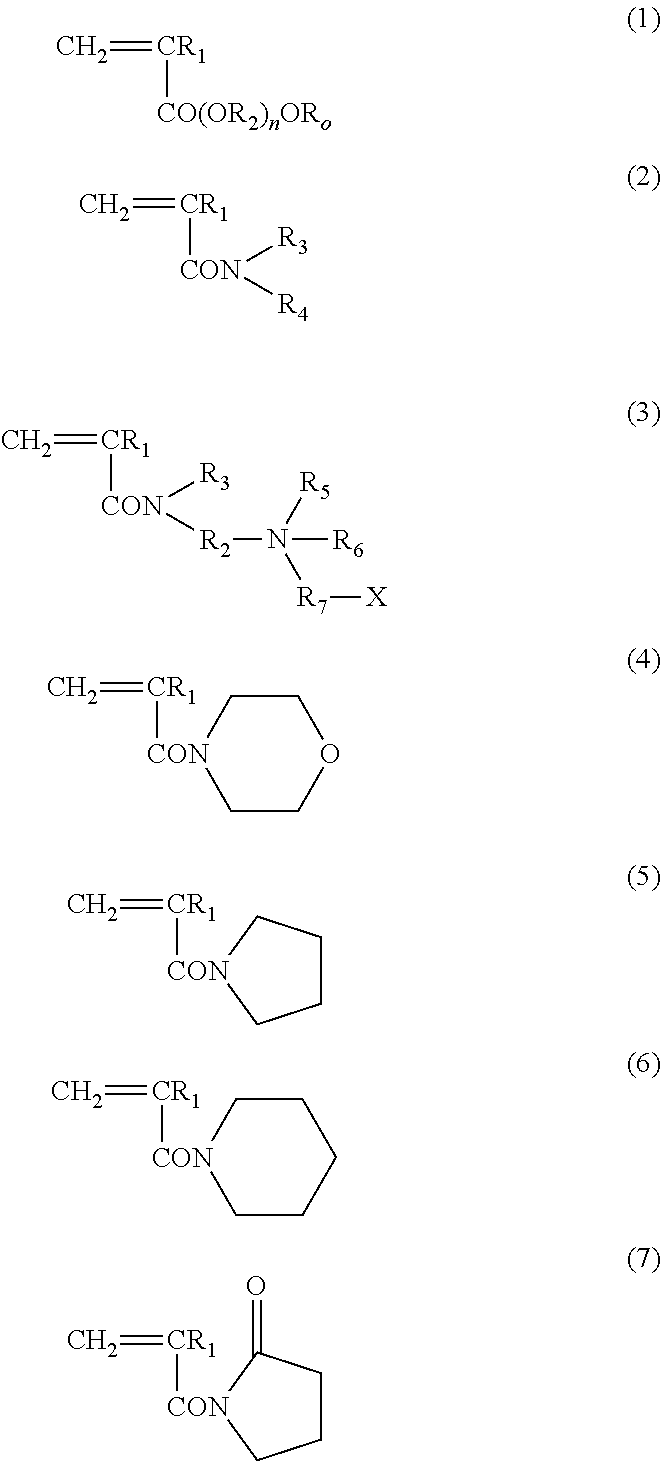Block copolymer and antithrombotic coating agent
a coating agent and copolymer technology, applied in the field of block copolymer and antithrombotic coating agent, can solve the problems of limited time for medical activity using such a medical instrument, many materials among those explained above do not have blood compatibility, and the continuous availability time of anticoagulant is limited, so as to achieve high solubility or dispersibility, good balance, and high uniformity
- Summary
- Abstract
- Description
- Claims
- Application Information
AI Technical Summary
Benefits of technology
Problems solved by technology
Method used
Image
Examples
example 1
Synthesis of Block Copolymer
[0104]After bubbling 1.46 g of 2-methoxyethyl acrylate (Toagosei Co. Ltd.) as the monomer (a), 0.0163 g of 2-(dodecyl thiocarbonothioyl thio)-2-methylpropionic acid (Sigma-Aldrich Co. LLC.) as the RAFT agent, 0.0007 g of 2,2′-azobisisobutyronitrile, and 10 mL of 1,4-dioxane with nitrogen, the mixture was stirred at 70° C., for 13 hours. Then, 6.66 g of N,N-dimethyl acrylamide (KOHJIN Holdings Co., Ltd.) as the monomer (b), and 10 mL of 1,4-dioxane were added, and further stirred at 70° C., for 24 hours. After the completion of reaction, the reaction solution was added to diethyl ether. After washing with diethyl ether three times, the reaction product was dried under vacuum, and thereby an A-B type block copolymer was produced.
[Identification of Polymer]
[0105]The reaction solution was put in deuterated chloroform, and the 1H-NMR spectrum was measured using JNM-LA 300 (JEOL Ltd.). As a result of the measurement, the conversion ratio of the monomers (a) and...
example 2
Synthesis of RAFT Agent
[0114]In accordance with Non-Patent Document “Macromolecules, 35, 6754 (2002)” a RAFT agent, 2-(1-carboxy-1-methyl ethyl sulfanyl thiocarbonyl sulfanyl)-2-methyl propionic acid, was synthesized as shown below.
[0115]10.1 g of 50%-sodium hydroxide was added to a mixture of 2.62 g of acetone. 5.38 g of trichloromethane, 0.12 g of tetrabutylammonium hydrogen sulfate, 1.37 g of carbon disulfide, and 6 mL of hexane, and the obtained mixture was stirred for 5 hours. After that, the reaction solution obtained was left to rest overnight, and the entire reaction solution was solidified. Then, 45 mL of water was added to dissolve the solidified reaction solution, and 6 mL of concentrated hydrochloric acid was added. A precipitate was obtained by bubbling nitrogen in the solution. After filtrating and washing the precipitate with water, the precipitate was dried. Then, 934 mg of a pale yellow crystal was obtained by recrystallizing with 60%-acetone aqueous solution.
[0116]...
example 3
Synthesis of Block Copolymer
[0126]An A-B-A type block copolymer was synthesized in a manner identical to that of Example 2, except that a mixture (molar ratio (a):(b); between the monomer (a) and the monomer (b) was 40:60) of 3.50 g of the monomer (a) and 4.00 g of the monomer (b) was used instead of the monomer (b).
[Identification of Polymer]
[0127]Similar to Example 1, the 1H-NMR spectrum was measured. As a result of the measurement, the conversion ratio of the monomers (a) and (b) was 100% and 99.1%, respectively.
[0128]The theoretical molecular weight of the polymer (A), the polymer (B), and the block copolymer was calculated using the conversion ratios above and the formula (16) above. As a result, the theoretical molecular weight, Mn, of the polymer (A) and the polymer (B) in the A-B type block copolymer, and the A-B type block copolymer was about 32,500 (250 mol), about 166,500 (1490 mol), and about 231,500, respectively.
[Preparation of Coating Film Containing Block Copolymer]
[...
PUM
| Property | Measurement | Unit |
|---|---|---|
| glass transition point | aaaaa | aaaaa |
| glass transition point | aaaaa | aaaaa |
| phase transition temperature | aaaaa | aaaaa |
Abstract
Description
Claims
Application Information
 Login to View More
Login to View More - R&D
- Intellectual Property
- Life Sciences
- Materials
- Tech Scout
- Unparalleled Data Quality
- Higher Quality Content
- 60% Fewer Hallucinations
Browse by: Latest US Patents, China's latest patents, Technical Efficacy Thesaurus, Application Domain, Technology Topic, Popular Technical Reports.
© 2025 PatSnap. All rights reserved.Legal|Privacy policy|Modern Slavery Act Transparency Statement|Sitemap|About US| Contact US: help@patsnap.com



